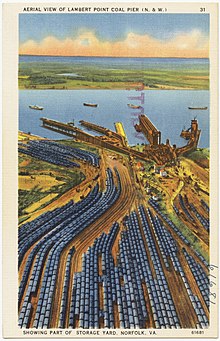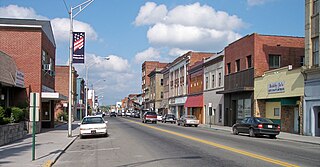
Princeton, is a city in and the county seat of Mercer County, West Virginia, United States. The population was 5,872 at the 2020 census. It is part of the Bluefield micropolitan area. The city hosts the Princeton WhistlePigs baseball club of the Appalachian League.

The Virginian Railway was a Class I railroad located in Virginia and West Virginia in the United States. The VGN was created to transport high quality "smokeless" bituminous coal from southern West Virginia to port at Hampton Roads.

The Norfolk and Western Railway, commonly called the N&W, was a US class I railroad, formed by more than 200 railroad mergers between 1838 and 1982. It was headquartered in Roanoke, Virginia, for most of its existence. Its motto was "Precision Transportation"; it had a variety of nicknames, including "King Coal" and "British Railway of America". In 1986, N&W merged with Southern Railway to form today’s Norfolk Southern Railway.
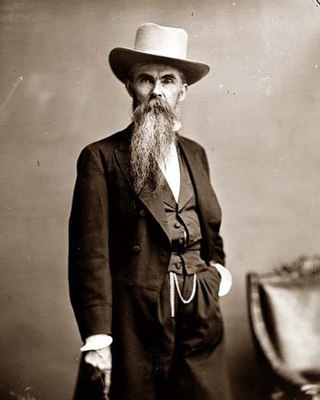
William Mahone was an American civil engineer, railroad executive, Confederate States Army general, and Virginia politician.

Frederick James Kimball was a civil engineer. He was an early president of the Norfolk and Western Railway and helped develop the Pocahontas coalfields in Virginia and West Virginia.

Otelia Butler Mahone from Smithfield, Virginia was a nurse during the American Civil War and the wife of Confederate Major General William Mahone, who was a civil engineer, teacher, railroad builder, and Senator in the United States Congress. Popularly known in Virginia as the "Hero of the Battle of the Crater" during and after the Civil War, her small-of-stature husband was nicknamed "Little Billy." An illustrious "character" in her own right, strong-willed Otelia Butler Mahone became almost as well known as her famous husband. She is credited by local legend with the naming of the towns of Windsor, Ivor, Wakefield, Waverly and Disputanta along the famous 52-mile tangent railroad tracks engineered and built by her husband between the cities of Suffolk and Petersburg. When he led the formation of the Atlantic, Mississippi and Ohio Railroad (AM&O) from three trunk lines across the southern tier of Virginia in 1870, wags claimed the initials stood for "All Mine and Otelia's."

Disputanta is an unincorporated community and census-designated place in Prince George County, Virginia, United States in the Richmond-Petersburg region and is a portion of the Richmond Metropolitan Statistical Area (MSA). The postal ZIP Code of Disputanta, Virginia is 23842. It was first listed as a CDP in the 2020 census with a population of 373.

The Norfolk and Petersburg Railroad was built between Norfolk and Petersburg, Virginia and was completed by 1858. The line was 85 miles (137 km) of 5 ft track gauge.
Francis Mallory was an American naval officer, physician, and railroad executive, who as a Whig politician served two terms in the United States House of Representatives representing Virginia's 1st congressional district. He later served two terms in the Virginia House of Delegates representing Norfolk.
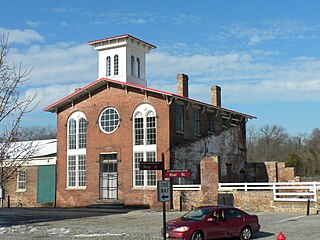
The Southside Railroad was formed in Virginia in 1846. Construction was begun in 1849 and completed in 1854. The 5 ft gauge railroad connected City Point, a port on the James River with the farm country south and west of Petersburg, Virginia, to Lynchburg, Virginia, a distance of about 132 miles (212 km).
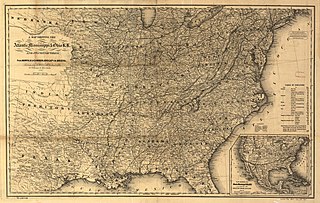
Atlantic, Mississippi and Ohio Railroad (AM&O) was formed in 1870 in Virginia from three east–west railroads which traversed across the southern portion of the state. Organized and led by former Confederate general William Mahone (1826-1895), the 428-mile (689 km) line linked Norfolk with Bristol, Virginia by way of Suffolk, Petersburg, Lynchburg, and Salem. The AM&O was promoted as a trade link to the west, and further expansion was envisioned with the goal of increasing Virginia's Ohio Valley and Mississippi Valley commerce. It was heavily backed by investors from England and Scotland.
The Virginia and Tennessee Railroad was an historic 5 ft gauge railroad in the Southern United States, much of which is incorporated into the modern Norfolk Southern Railway. It played a strategic role in supplying the Confederacy during the American Civil War.

The Norfolk Southern Railway was the final name of a railroad that ran from Norfolk, Virginia, southwest and west to Charlotte, North Carolina. It was acquired by the Southern Railway in 1974, which merged with the Norfolk and Western Railway in 1982 to form the current Norfolk Southern Railway.

Transportation in the Commonwealth of Virginia is by land, sea and air. Virginia's extensive network of highways and railroads were developed and built over a period almost 400 years, beginning almost immediately after the founding of Jamestown in 1607, and often incorporating old established trails of the Native Americans.
A coal pier is a transloading facility designed for the transfer of coal between rail and ship.
The Seaboard and Roanoke Railroad was organized in 1833 to extend from the area of the rapids of the Roanoke River at its fall line near Weldon, North Carolina to Portsmouth, Virginia, across the Elizabeth River from Norfolk on the harbor of Hampton Roads.

The Pocahontas was one of the named passenger trains of the Norfolk and Western Railway. It was an overnight train between Norfolk, Virginia, and Cincinnati, Ohio, with a through-car to and from Chicago, Illinois. The Pocahontas ran from November 1926 until May 1971.

Lambert's Point Deperming Station is a United States Navy deperming facility located in the Elizabeth River just off Lambert's Point, Norfolk, Virginia, United States. It was built in the mid-1940s and services the U.S. Atlantic Fleet.

U.S. Route 460 (US 460) in Virginia runs west-east through the southern part of the Commonwealth. The road has two separate pieces in Virginia, joined by a relatively short section in West Virginia. Most of US 460 is a four-lane divided highway and is a major artery in the southern third of the state. From Petersburg to Suffolk, US 460 is a four-lane non-divided highway. It is a popular alternative to Interstate 64 (I-64) when going from Richmond and other points in central Virginia to the Currituck Sound and Outer Banks of North Carolina, avoiding the congestion and tunnels of the more northerly I-64 corridor. The road passes through several small towns that built up at stops along the railroad line.

